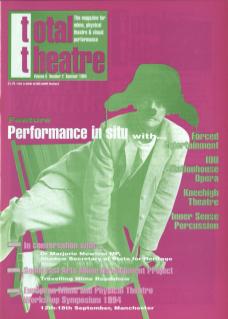Mime is currently undergoing a process of defining itself and identifying the needs of performers and audiences alike. The recent Mime and Physical Theatre Training Directory published by Mime Action Group and compiled by Neil Blunt at Arts Training Project, De Montfort University, identifies the range of influences and associations which mime can be said to embrace. These range from Biomechanics to Bouffon and Creation of Narrative through Movement to interdisciplinary dance/theatre, etc. This extensive range of performance styles is reflected in the 1994 London International Mime Festival which included ‘post-punk’ Russian clowns, Japanese Byu-Tal, Juggling and Circus Theatre amongst the more usual array of work by companies and solo artists.
Just as Mime Action Group seek to open the debate about mime in Britain, so discussion on a wider scale is taking place in other European countries. The theme of the 1993 European Mime Federation Congress held in Berlin was Reconstruction and Innovation and sought to examine the work of key twentieth century artists such as Decroux, and to put their work into a modern context. The Congress seemed to be divided into those who held Decroux technique as sacrosanct and those who were open to other forms including Decroux technique. Théâtre de l'Ange Fou set out to achieve Decroux style in performance and is run by Corinne Soum and Steve Wasson, who both trained with him and now seek to keep his teaching alive. They place great emphasis on this rigid training and say that you should give yourself over to a ‘genius’ in order to try to go beyond your own capabilities.
Kari Margolis and Tony Brown of the New York performance group The Adaptors also trained with Decroux and place great importance on this training and the learning process. They differ from Théâtre de L'Ange Fou in where they have taken this technique in their performance. The work of The Adaptors could be categorised as multimedia performance using powerful contemporary images tinged with key ingredients of the post-modern such as pastiche and kitsch and combining them with the brilliance of Decroux's vocabulary of movement. Thus we see a fleet of women ‘sailing’ with their ironing-boards or a giant bed where four men and four women enact out all aspects of human life. This is a more open form of theatre that seeks to include and draw references from a wide variety of sources.
The European Mime Federation commissioned a Dramaturgy Model Project which involved over fifty artists and theoreticians responding in a completely free-frame manner to six video tapes by unidentified artists. Leaving aside for a minute the method of the project which used recordings rather than the live experience as a base for response, it has nevertheless led to some interesting findings. What seems to emerge is that there are no longer any rules about defining work, no single answer, but rather that artists should come to understand their own role and the nature of their art. This self-definition or 'selbstverstandnis' represents a rejection of the idea that the production and judgement of works of art should be based on a consensus within the art community, on aesthetic and ethical standards. Dramaturgists, it would seem, in seeking to explain and interpret, continually only find more questions. We need, therefore, to question the value of such interpretation, who it is for, and how the work will benefit. What mime artist would like to have a dramaturgist tell him how best to create his performance? Yet there is a need for the well informed mime critic and appraisal of work. We are at least aware of this, perhaps with one eye on the funders, but also out of awareness of training needs and raising the profile of a medium that has traditionally fallen between the cracks of dance and drama. We have moved a long way from an artform that can only claim Marceau and Chaplin as its champions, but still lags behind in many respects. Mime, the ‘quintessential technique for expressing the ineffable’, struggles without a framework to give it meaning. Although mime leans towards the inclusion of a wide range of reference it almost always operates on the basis that the audience are able to translate its meaning via a thread of suggested ideas. Christian Mattis, founder and director of the Paradogs movement theatre group in Zürich, bemoans the lack of development and experimentation within the artform:
‘When is mime going to produce its Beuys, its Steve Reich, its Ernst Jancil or Marguerite Duras? Even Decroux had a lot more to tell and was less rigid in his opinions than his present-day adepts would make him.’ (Maanblad Over Theatedans en Mime, May 1993)
Ultimately the development of mime will be the outcome of a process between theory, practice and audience that reflects the present culture. On stage, screen, in the street, at conferences, even the Olympic Games, mime has the ability to transcend the word and this is an exciting time to be working in it.
Taken from an essay entitled 'Post-modernist Mime? A critical examination of the current state of mine in relation to trends in postmodern performance', January 1994. Phil Gunderson is a student on the MA Performing Arts course at Middlesex University.

